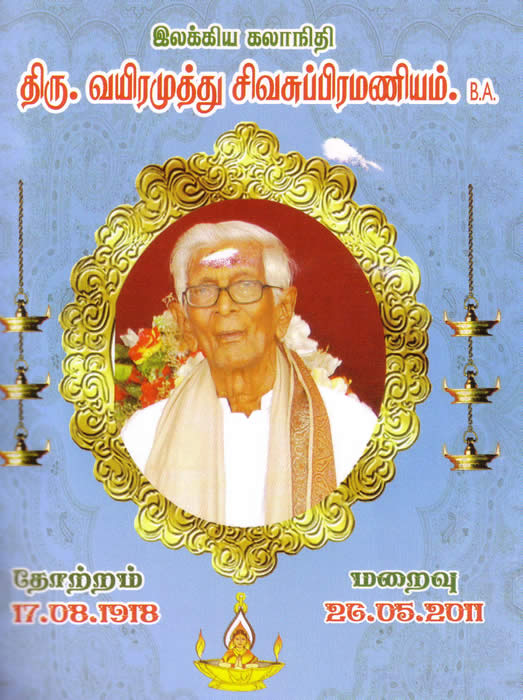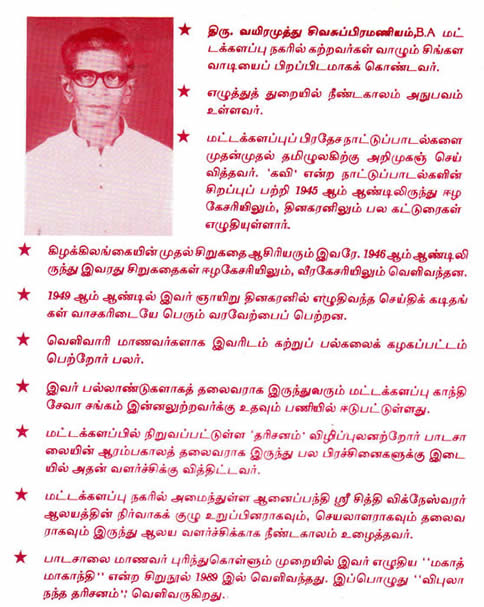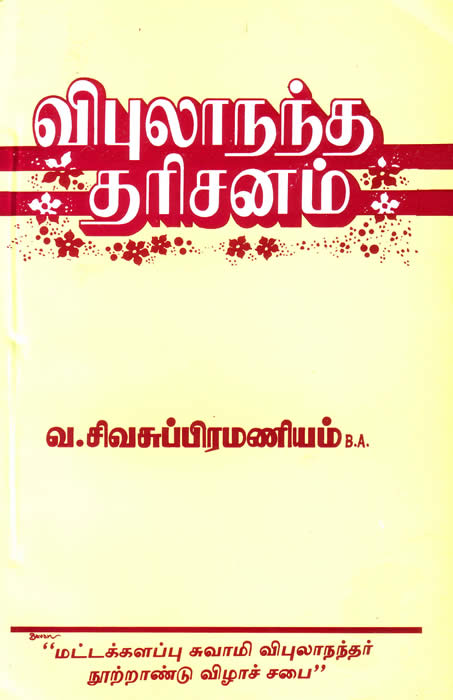Ilankai Tamil Sangam30th Year on the Web Association of Tamils of Sri Lanka in the USA |
|||
 Home Home Archives Archives |
Vairamuthu Sivasubramaniam (1918-2011)In Memoriamby Sachi Sri Kantha, 23 July, 2011
Here is a brief bio-data of Sivasubramaniam Aiyah’s career. He was born in 1918 August 17 at Sinhala Vadi, Batticaloa. His father Arumugam Vairamuthu was from Maviddapuram, Jaffna. His mother Annapillai was from Sinhala Vadi, Batticaloa. From 1925, young Sivasubramaniam came into contact with Swami Vipulananda. After receiving his Teachers Certificate in 1936, Sivasubramaniam taught at many schools in the Eastern Province, and finally retired from services in 1973 after teaching at Batticaloa Sivanantha Vidyalayam. While being a teacher, Sivasubramaniam Aiyah also received his B.A degree as an external candidate in 1968, passing in Tamil Sanskrit and Indian history. It is to the credit of Sivasubramaniam Aiyah that in 1940s he took interest in collecting and compiling the folk songs of Batticaloa region. His short stories did appear regularly in the popular newspapers such as Eelakesari, Virakesari and Thinakaran. Late in his life, Sivasubramaniyam Aiyah published noticeable books in Tamil, such as Vipulananda Tharisanam (1993), Suruthi Nool Murai (1999) and Mattakalappu Naatariyal (2004). Each of these three books had distinct imprimaturs. Vipulananda Tharisanam was homage to his mentor. Suruthi Nool Murai was an exposition of ancient Tamil script located in the Eastern province. Mattakalappu Naatariyal was one of the profound folk histories we have now about Batticaloa region and Tamil settlements.
Collecting such scattered materials that were published in pre-independent India and Ceylon, making arrangements to fund the publishing project and printing them, proof-reading the text, and completing the task (considering the travails of publishing them in Batticaloa during the civil war period) was an effort only strong willed scholars like Sivasubramaniam Aiyah could achieve. Such a devotion to what is called in Indian tradition ‘guru bhakti’, is meritorious indeed.
*****
|
||
|
|||
 Eelam Tamils lost a nonagenarian Tamil scholar, when Vairamuthu Sivasubramaniam bid adieu to us on May 26th of this year, at the age of 92 years. In my view, Sivasubramaniam Aiyah was one of the ‘silent’ Tamil scholars, who shunned publicity. As he did not belong to either the academic circles of the Sri Lankan universities or the media (print, radio and TV) circles, he was less noticed in comparison to ‘empty vessels’ that had much exposure. In the last quarter of the 20th century, Sivasubramaniam Aiyah served as one of the last links, who did personally interact with Swami Vipulananda (1892-1947), the first Tamil professor of the then University of Ceylon.
Eelam Tamils lost a nonagenarian Tamil scholar, when Vairamuthu Sivasubramaniam bid adieu to us on May 26th of this year, at the age of 92 years. In my view, Sivasubramaniam Aiyah was one of the ‘silent’ Tamil scholars, who shunned publicity. As he did not belong to either the academic circles of the Sri Lankan universities or the media (print, radio and TV) circles, he was less noticed in comparison to ‘empty vessels’ that had much exposure. In the last quarter of the 20th century, Sivasubramaniam Aiyah served as one of the last links, who did personally interact with Swami Vipulananda (1892-1947), the first Tamil professor of the then University of Ceylon. Though these contributions of Sivasubramaniam Aiyah deserve praise, what I consider his greatest achievement was in editing the oeuvre (in collaboration with Vidwan S.E.Kamalanathan) of his mentor Swami Vipulananda, and publishing it in four parts. Altogether, these four parts brought together 162 items of Swami’s published prose and poetry in Tamil and English, between 1914 and 1947. The details of these four parts are as follows:
Though these contributions of Sivasubramaniam Aiyah deserve praise, what I consider his greatest achievement was in editing the oeuvre (in collaboration with Vidwan S.E.Kamalanathan) of his mentor Swami Vipulananda, and publishing it in four parts. Altogether, these four parts brought together 162 items of Swami’s published prose and poetry in Tamil and English, between 1914 and 1947. The details of these four parts are as follows: